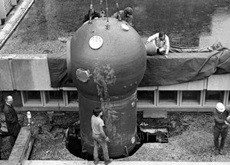Fifty-One Years of History

The initial chamber for Hypo-Hyperbaric research was installed at Duke in 1963. During the years between 1963 and 1968, the major investigational activity was directed toward descriptive studies of the effects of hyperbaric oxygen. Oxygen toxicity, problems of oxygen transport through defective macro and micro circulations, physiological effects of hyperoxia upon intact organisms and specific body organs, relevant pathological studies, and biochemical investigations at the cellular level were the major concerns. These pioneering studies resulted primarily in better definition of processes that limited the therapeutic exploitation of hyperbaric oxygen. Many of the basic biochemical and pharmacological mechanisms of action of oxygen, however, remain under investigation.
Construction of the F.G. Hall Laboratory – now part of the Center For Hyperbaric Medicine And Environmental Physiology ( named after Frank Gregory Hall, pictured left) was completed in 1968. Six large chambers were installed which gave capacity to simulate depths of 1000 feet of seawater (fsw) and up to 100,000 feet of altitude. Dr. Herbert Saltzman was named Director of the Laboratory. Under his direction, program investigators emphasized studies of cardiopulmonary, hematologic and neurologic consequences of exposure to substantially high or low atmospheric pressure. The increase and decrease of atmospheric pressures, in association with specialized breathing gases as forcing functions, were used to address such diverse questions as the effects of inert gases on ventilatory control, psychomotor effects of greatly increased atmospheric pressure on man, consequences of immersion and simulated altitude on gas exchange in man and the effects of gas density and atmospheric pressure on ventilatory control and gas exchange. Basic questions have also been investigated concerning the membrane effects of inert gases and anesthetic mechanisms. Extensive applied studies aimed at understanding clearance of gases from body tissues during decompression from depth and to altitude also have been noteworthy.
In 1978, two additional chambers (pictured below) were installed to extend the range of studies involving increased pressure. These chambers permit both human and animal studies at simulated depths up to 3600 fsw. Four deep manned dives (up to 69.5 ATA) were conducted in these chambers between 1978 and 1984 (Atlantis dive series) under the directorship of Dr. Peter B. Bennett. In 1986, the F. G. Hall Laboratory became a University Center and in 1990 Dr. Claude A. Piantadosi became the Director. In 1998, the facility was designated the Center for Hyperbaric Medicine and Environmental Physiology.
Overall, more than 1000 scientific publications have come from the Center For Hyperbaric Medicine And Environmental Physiology since 1963. This 42-year record of productivity represents a truly interdisciplinary approach involving scientists from the Departments of Anesthesiology, Medicine, Physiology, Surgery, Ophthalmology, Pathology, Pediatrics, Mechanical Engineering and the Duke Marine Laboratory. One of the primary goals of today’s program is to preserve and strengthen this tradition of interdisciplinary research.
The laboratory also has attracted a wide variety of extramural scientists interested in problems of Environmental Physiology. These collaborative efforts have involved consultative, educational, clinical and basic science research programs. Investigators regularly visit from internationally recognized environmental centers in Canada, Japan, Norway, Germany, Sweden, and England. From within the U.S., research support has come from the National Heart Lung and Blood Institute, the National Oceanic and Atmospheric Agency, the U.S. Navy, NASA, the U.S. Air Force, the Divers Alert Network and the commercial offshore diving industry. The results of this research are in use today helping to decrease the morbidity and mortality of divers as well as providing the rationale for clinical treatment of patients with diseases induced by gas bubbles such as decompression sickness and arterial gas embolism. These studies also have provided a scientific foundation for the clinical practice of Hyperbaric Medicine, which has grown within the Center For Hyperbaric Medicine And Environmental Physiology to provide new investigative opportunities in the field. Presently, basic science research support is provided by the National Heart Lung and Blood Institute to increase our understanding of the beneficial and toxic effects of oxygen.